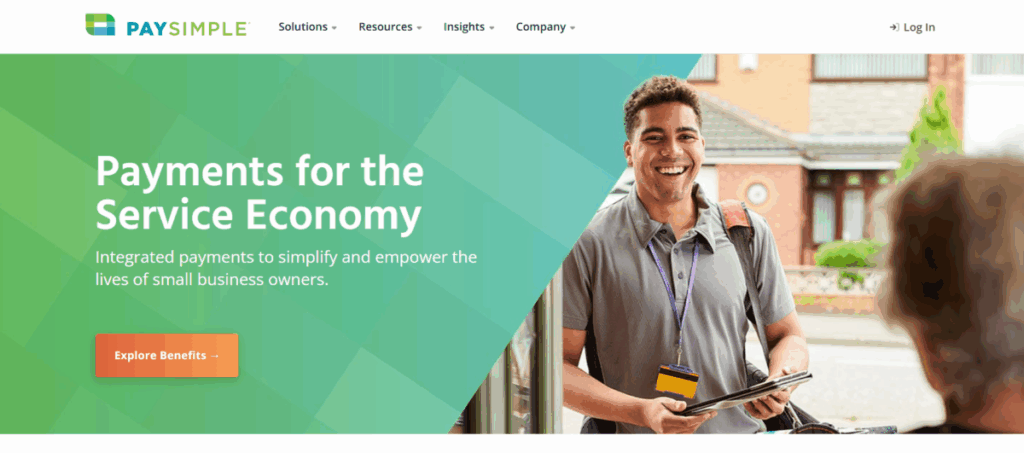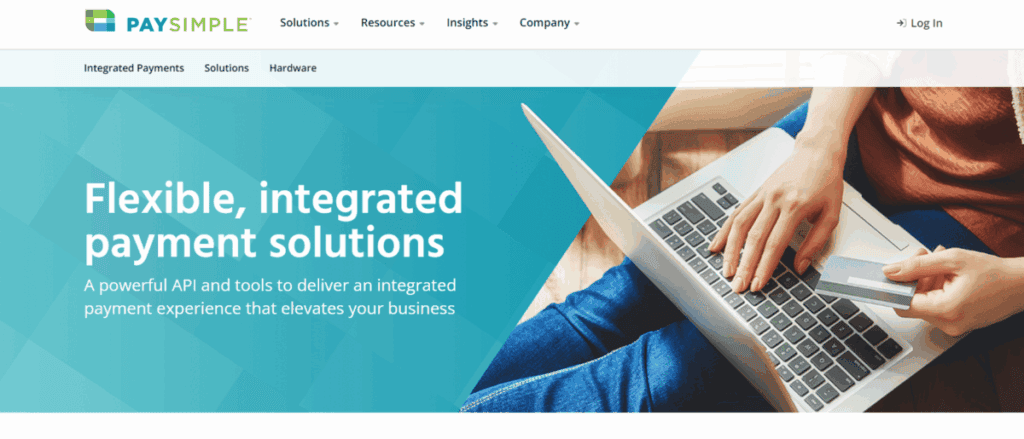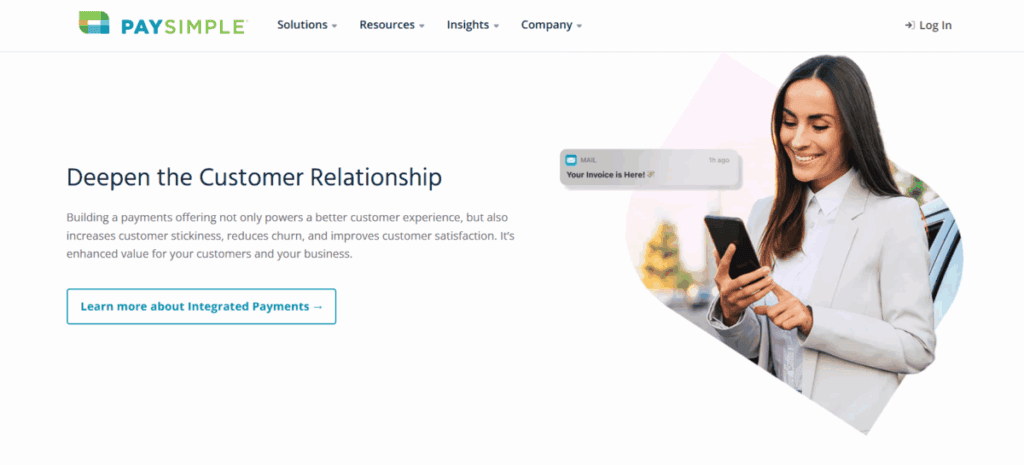
PaySimple Review
- 11th Jul, 2025
- | By Linda Mae
- | Reviews
PaySimple is a payment and customer management solution designed primarily for service-based small and mid-sized businesses. It helps business owners streamline billing, accept online and offline payments, and manage clients with minimal technical expertise. The platform offers tools that go beyond basic payment processing, including invoicing, recurring billing, appointment scheduling, and customer tracking. Lets read more about PaySimple Review.
Unlike traditional merchant service providers, PaySimple bundles business operations into one cohesive platform. Its focus is on simplifying the life of service providers such as wellness practitioners, consultants, home service professionals, and other field-based businesses. This positions PaySimple as a hybrid between a CRM tool and a payments gateway, with added value for those looking to centralize operations.
However, PaySimple is not designed to serve every business type. It is not ideal for high-volume retail or product-heavy eCommerce businesses that require inventory management or advanced online storefronts. Instead, it delivers best results for businesses that rely heavily on recurring clients, invoice-based payments, or appointment-driven workflows.
The platform is cloud-based, accessible from any device with internet connectivity, and does not require extensive onboarding to get started. This makes it an appealing option for non-technical business owners who want to digitize operations without investing in complex software infrastructure. As we take a look at each core function in the sections ahead, we will assess how PaySimple performs in terms of usability, feature depth, and overall value to growing service providers.
Table of Contents
ToggleCore Features Overview | PaySimple Review
PaySimple brings it all together for businesses to manage payments and customer relationships. At the heart of it is a payment acceptance engine that supports credit cards, ACH transfers and recurring billing. This makes it easier for service based businesses to get paid on time and manage client interactions smoother.
The platform has customizable invoicing tools to create branded invoices and automate payment reminders. Great for businesses that deal with repeat clients or offer payment plans. Also included are appointment scheduling tools that are integrated with the payment system so clients can book and pay for services online.
Another big feature is customer management. The platform stores customer contact info, payment history and communication logs so you have a clear record of each relationship. This is a CRM without a separate tool.
PaySimple also has a virtual terminal to accept payments over the phone and hosted online payment forms that can be embedded into business websites. Great for remote or mobile businesses that don’t have a physical location.
Overall the all in one approach means you use fewer tools daily and have better oversight. While the depth of each feature may not be as good as best in class tools, the convenience of having them all in one place is what makes PaySimple attractive to our target market.

Online Payment Acceptance Tools
PaySimple offers multiple options for businesses to accept online payments securely and efficiently. Its system supports credit card processing and ACH bank transfers, providing flexibility to both the business and its customers. This is particularly beneficial for industries where clients may prefer non-card-based methods of payment, such as consulting or healthcare.
The platform enables the creation of hosted payment forms that can be shared via email, embedded on websites, or sent as links to customers. These forms are customizable with the business’s branding and allow for one-time or recurring payments. This setup is ideal for service providers who need an easy way to accept payments without investing in a separate web store.
PaySimple also includes a virtual terminal that lets users enter payment information on behalf of a customer during phone transactions. This feature can be essential for businesses that operate via call-ins or on-the-go appointments, such as repair services or coaching. Recurring billing is another strength. Businesses can set up automated payment plans on a daily, weekly, or monthly basis, reducing the administrative load of managing invoices manually. Payment data is securely stored, and the system is compliant with PCI standards.
Overall, the online payment tools are robust enough for service-focused businesses. While it may lack more advanced features like one-click checkout or integrations with point-of-sale hardware, PaySimple covers the essentials for companies that prioritize ease of use and recurring revenue over transactional volume.
Invoicing and Billing Capabilities
PaySimple offers a reliable invoicing system tailored to the needs of small businesses that bill for services rendered. Users can create and send branded invoices directly from the platform and monitor the status of each one, whether it is viewed, paid, or overdue. This real-time tracking makes it easier to stay on top of accounts receivable without additional tools.
The platform supports both one-time and recurring invoicing. For businesses that offer subscriptions or long-term service contracts, this feature streamlines operations. Payment reminders can be automated, reducing the likelihood of delayed payments without the need for repeated manual follow-ups. Customization is another useful aspect. Invoices can include logos, line-item descriptions, due dates, taxes, and discounts. Businesses can also include links to online payment forms, enabling customers to pay instantly using their preferred method.
Recurring invoices can be configured to run on flexible schedules. For example, a consultant offering monthly retainer services can automatically bill clients on the first of each month, with payment processing and confirmation handled in the background.
Although the invoicing tool lacks some of the advanced options found in dedicated accounting software, such as multi-currency support or deep financial reporting, it adequately serves the needs of local and regional service providers. The simplicity and automation of the billing system help save time while maintaining a professional appearance.
Customer Management System
PaySimple has a lightweight customer management system where you can store and organize customer information along with payment history and communications. This built-in CRM is perfect for businesses that have long term relationships with customers rather than one time transactions.
Each customer profile has contact info, notes, transaction history and scheduled appointments. You can quickly access this info when creating invoices or confirming payment details which reduces errors and improves the customer experience. The platform also supports tagging and segmentation so you can filter or group customers for targeted communications.
Not as advanced as a full CRM like Salesforce or HubSpot, but the simplicity of PaySimple’s customer management system means you can use it without any training. For small teams or solo entrepreneurs this is a big advantage.
Businesses that interact with repeat customers frequently like fitness trainers, therapists or tutors will find the customer history feature especially useful. It allows you to build rapport and improve service over time. Storing payment preferences in customer profiles also means faster transactions and less errors.
But if you’re looking for lead generation tools, complex sales pipelines or integration with marketing platforms you may find this system limited. Still for service businesses that need basic customer records tied to billing and scheduling it’s a functional and easy to use solution.
Scheduling and Appointment Booking Integration
One of PaySimple’s distinguishing features is its built-in scheduling tool that allows businesses to offer online appointment booking alongside payment collection. This function is particularly well-suited for service-based industries such as salons, consulting agencies, tutoring centers, and wellness practitioners.
Clients can view available time slots, select services, and pay in advance when booking their appointments. This helps businesses reduce no-shows, streamline payments, and improve customer satisfaction. The scheduling interface is clean and easy to embed into websites or link through emails and social media.
PaySimple gives users the flexibility to create service menus, set working hours, and define cancellation policies. Appointments are then synced with the payment system, so there is no need for separate software or reconciliation of transactions later. For businesses with multiple staff members or locations, scheduling rules can be set individually, ensuring each team member’s availability is correctly displayed. Reminders can also be sent to both the business and the customer to prevent missed appointments.
The integration of scheduling with invoicing and payments makes PaySimple a time-saving tool for small businesses. However, the appointment features are not as detailed as those in full-fledged scheduling platforms. For example, there are limited options for integrating with external calendars like Google or Outlook. That said, for businesses that want a simple solution without managing multiple software subscriptions, the built-in booking system offers enough value to be considered a key strength.

Mobile and Remote Payment Features
PaySimple has mobile and remote payment capabilities so it’s perfect for businesses that operate in the field or across multiple locations. The platform has a mobile optimized interface and a virtual terminal so you can accept payments on the go from your smartphone, tablet or laptop.
Mobile is great for service providers who go to the client, like home repair professionals, mobile massage therapists or field consultants. Through the web dashboard or mobile access you can send invoices, collect credit card or ACH payments and view real time payment status.
PaySimple does not have its own mobile app for iOS or Android which could be a drawback for some users. But the responsive web portal does most of the same functions and is accessible from any device with an internet connection. Plus the virtual terminal allows you to key in card info for phone or mail orders. This is super helpful for businesses without a storefront or card reader. It’s secure, easy to use and integrated with the rest of the platform.
The platform doesn’t have advanced hardware solutions like mobile card readers or point of sale systems but it has the essentials for businesses that need flexibility and remote operations. It may not be enough for high volume mobile retailers but it’s more than enough for service professionals who do a moderate amount of transactions in the field.
Reporting and Analytics
PaySimple includes a reporting and analytics module that helps business owners keep track of payments, outstanding invoices, customer behavior, and general financial health. The system offers a variety of pre-built reports, such as revenue summaries, payment history, invoice status, and customer activity logs.
These reports can be filtered by date range, payment type, or customer segment, giving users flexibility in how they analyze their data. For example, a business can quickly identify its top-paying customers or evaluate how recurring billing plans are performing over time.
While the reporting tools are not as advanced as those in full accounting software, they cover the essentials well. Users can export data to spreadsheets for further analysis or use it for bookkeeping and tax purposes. The visual layout is easy to understand, which is helpful for users without a financial background.
The dashboard offers quick-glance widgets that display key performance indicators, such as total revenue this month or overdue invoices. This helps busy business owners stay informed without digging into detailed reports unless needed.
One limitation is the absence of real-time integration with external accounting platforms for full double-entry bookkeeping. However, the insights provided are enough to support most small service businesses in managing their cash flow, customer trends, and payment follow-ups. Overall, the analytics features are user-friendly and functional, helping to improve decision-making with minimal effort.
User Experience and Interface Design
PaySimple is designed with simplicity in mind. Its interface is clean, intuitive, and free of unnecessary complexity, making it ideal for business owners who are not technically inclined. The dashboard is organized in a way that allows users to easily navigate between customers, invoices, reports, and payments.
During onboarding, users are guided through initial setup steps like connecting a bank account, creating a payment form, and sending their first invoice. This ease of setup is a major advantage for small businesses that do not have a dedicated IT team or the resources to hire technical help.
The platform’s layout emphasizes accessibility. Most functions are available within a few clicks from the main navigation bar, and the help documentation is integrated contextually, offering guidance as users interact with various tools.
While the interface is responsive and mobile-friendly, the lack of a native mobile app can be a slight inconvenience for users who prefer app-based management. Still, the mobile-optimized web portal performs well across devices and browsers.
PaySimple may not have the sleek aesthetics of newer fintech startups, but it prioritizes usability and functional clarity over design flair. The interface avoids distractions and ensures that critical functions—such as billing, scheduling, and payments—are straightforward to use. For service-based businesses that value efficiency and low learning curves, the platform delivers a positive overall user experience.
Security and Compliance Standards
Security is a critical component of any payment processing system, and PaySimple adheres to industry standards to protect both businesses and their customers. The platform is PCI DSS compliant, ensuring that sensitive payment information is processed and stored securely.
One of the key security measures is tokenization. When a customer’s payment details are entered, they are replaced with a token—a string of characters that represents the data without exposing the actual information. This reduces the risk of fraud and unauthorized access.
PaySimple also uses SSL encryption for all data transfers and implements strict access controls within the platform. Users can manage permissions for employees, ensuring that only authorized individuals have access to financial or customer data.
Additionally, PaySimple monitors transactions for suspicious activity, offering businesses peace of mind. Businesses are notified if anomalies are detected, such as unusual payment amounts or multiple failed transactions from the same user.
Though the platform does not advertise advanced fraud detection or chargeback management tools like some enterprise-level systems, it provides a solid foundation of security suitable for small to medium service businesses. Users should still follow best practices like strong password policies and regular account reviews to further enhance safety.
In summary, PaySimple offers a secure environment for managing payments and customer information, complying with essential financial data standards. It strikes a balance between protection and ease of use, which is appropriate for the business segments it serves.
Integration and API Flexibility
PaySimple offers a range of integration options that allow users to connect it with other tools in their business ecosystem. These include popular platforms like QuickBooks for accounting, Mailchimp for email marketing, and Salesforce for CRM functions. These integrations help businesses maintain data consistency across systems and reduce manual work.
For developers or businesses with specific workflows, PaySimple provides a set of APIs that can be used to build custom applications or embed payment functionality into third-party platforms. These APIs cover areas like customer management, transactions, recurring billing, and reporting.
The API documentation is well-organized and includes usage examples, making it approachable even for small businesses with limited development resources. Businesses can create seamless customer experiences by integrating PaySimple into their websites, mobile apps, or back-office tools.
One limitation is that PaySimple does not support a large number of third-party integrations out of the box, compared to platforms that rely on Zapier or have extensive app marketplaces. This could be a drawback for businesses that rely on many cloud-based tools and want plug-and-play compatibility.
Still, for businesses that only need a handful of integrations or prefer a more controlled tech stack, PaySimple provides enough flexibility to meet operational needs. Its APIs allow room to scale gradually without needing to overhaul systems down the line.

Pricing Structure and Fees
PaySimple’s pricing is subscription-based, which can be advantageous for businesses that prefer predictable monthly costs over variable per-transaction pricing alone. The platform generally charges a flat monthly fee for access to its software features, alongside standard payment processing fees for transactions.
As of recent information, the monthly software subscription starts around $59.95, which includes access to payment acceptance, invoicing, customer management, and scheduling tools. In addition, there are transaction fees: approximately 2.49 percent plus a small fixed fee for credit cards, and lower percentages for ACH payments.
There are no long-term contracts required, and users can cancel on a monthly basis. However, some optional services—like advanced reporting, additional users, or custom integrations—may incur extra charges.
Compared to some competitors, PaySimple’s pricing is middle of the road. It is not the cheapest option on the market, but the bundled value it provides in terms of scheduling, customer management, and billing tools helps justify the cost.
Businesses considering PaySimple should review whether the included features match their needs closely enough to avoid paying for additional tools. Also, transaction-heavy businesses should calculate overall costs based on volume to ensure affordability over time.
Overall, PaySimple offers fair and transparent pricing for small service businesses, especially those that benefit from the integrated nature of its services.
Customer Support and Resources
Customer support is a critical factor when evaluating any business software, and PaySimple performs reasonably well in this area. Users can reach support through phone, email, or live chat during business hours. Most basic issues are addressed promptly, and the representatives are knowledgeable about platform functionality.
The company also provides an online help center with articles, guides, and video tutorials. These resources cover everything from setting up recurring billing to generating financial reports, making it easier for new users to find answers without waiting for support.
For businesses that need more hands-on guidance, PaySimple offers onboarding assistance for new accounts, including walkthroughs of the dashboard and help with initial setup. This is especially helpful for users who are new to payment processing or business automation tools.
One area where the platform could improve is weekend availability or extended support hours. For businesses operating outside of standard hours, limited access to support can be frustrating during urgent situations.
Despite that, PaySimple generally receives positive feedback for its customer service. The blend of self-service content and direct human support strikes a good balance, especially for small businesses that value personal interaction and timely assistance.
Who Should Use PaySimple?
PaySimple is well-suited for service-oriented small and mid-sized businesses that value simplicity, automation, and client management. Businesses such as health and wellness providers, consultants, tutors, home service professionals, and nonprofits will find the platform particularly beneficial.
These types of businesses often need to manage customer relationships over time, schedule appointments, send recurring invoices, and accept online payments. PaySimple bundles these tasks into one streamlined platform, eliminating the need to juggle multiple disconnected tools.
However, it may not be the right fit for high-volume retailers, restaurants, or inventory-driven businesses that require robust POS systems and product tracking. Nor is it ideal for large enterprises with complex integration needs or international operations.
If your business depends on appointments, client interaction, and timely payments, PaySimple offers excellent value. It reduces the manual effort associated with billing and follow-ups while presenting a professional image to customers. Its flat pricing model and included features make it predictable and easy to budget for, which is crucial for smaller operations.
Ultimately, PaySimple’s strength lies in its balance of payment processing, customer management, and scheduling within a user-friendly interface. It is a practical choice for businesses looking to digitize and streamline their operations without adding complexity.
FAQs
Q1. Can PaySimple handle international payments?
PaySimple primarily supports businesses operating within the United States and does not offer extensive support for multi-currency or cross-border transactions. It is best suited for domestic businesses.
Q2. Does PaySimple integrate with QuickBooks?
Yes, PaySimple integrates with QuickBooks, allowing users to sync invoices and payments with their accounting software for easier bookkeeping and financial reporting.
Q3. Is there a free trial available for PaySimple?
PaySimple offers a free demo and occasionally a trial period for new users. Interested businesses should contact the company directly to confirm current trial availability and conditions.
